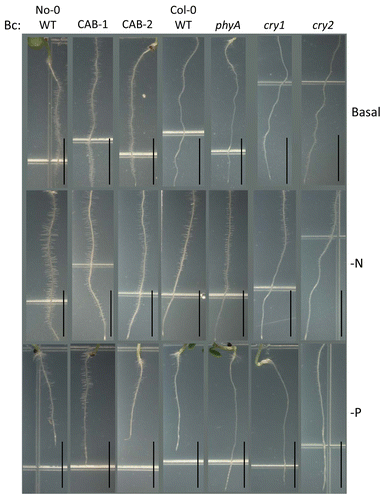Figures & data
Figure 1. Development and anthocyanin content of wild-type and phytochrome-deficient seedlings under continuous far-red light. No-0 wild-type (No-0 WT), CAB3::pBVR1 (CAB-1), CAB3::pBVR2 (CAB-2), Col-0 wild-type (Col-0 WT), and phyA (Salk_014575) seedlings were grown at 22 °C for 4 d or 12 °C for 10 d on basal (B), nitrogen-limited (-N), or phosphate-limited (-P) Phytoblend medium with 1% sucrose under continuous FR (FRc) illumination of 5 μmol m-2 s-1. (A, B) Images of seedlings. Scale bar represents 1 cm. (C, D) Anthocyanin content. Bars represent the mean (± SD) of at least 3 independent measurements. Numbers above each bar represent the percent of anthocyanins accumulated relative to WT grown on the same medium. Fold-increase values for anthocyanin levels for seedlings grown on nutrient-deficient medium relative to growth of the same line on basal medium are shown below the bar graph. Two-tailed, unpaired Mann-Whitney U-test analyses were performed to compare the means of anthocyanin contents per mg of fresh weight for a particular line on basal medium relative to respective nutrient limitations. Letters above bars: a, P < 0.001; b, P < 0.01; c, P ≤ 0.05.
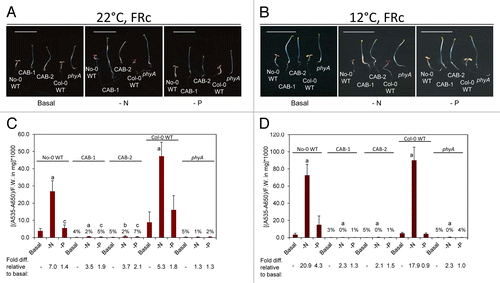
Table 1. Fold-difference values for anthocyanin levels determined for seedlings grown at 12 °C vs. 22 °C under different light conditions. No-0 wild-type (No-0 WT), CAB3::pBVR1, CAB3::pBVR2, Col-0 wild-type (Col-0 WT), phyA, phyB, cry1, and cry2 seedlings were grown on basal (B), nitrogen-limited (-N), or phosphate-limited (-P) medium at 12 °C or 22 °C under continuous far-red (FRc), red (Rc) or blue (Bc) illumination. Fold-difference values for anthocyanin content for seedlings grown at 12 °C relative to 22 °C are indicated (based on averages for 3 independent experiments)
Figure 2. Development and anthocyanin content of wild-type and phytochrome-deficient seedlings under continuous red light. No-0 wild-type (No-0 WT), CAB3::pBVR1 (CAB-1), CAB3::pBVR2 (CAB-2), Col-0 wild-type (Col-0 WT), and phyB (Salk_022035) seedlings were grown at 22 °C for 4 d or 12 °C for 10 d on basal (B), nitrogen-limited (-N), or phosphate-limited (-P) Phytoblend medium with 1% sucrose under continuous R (Rc) illumination of 50 μmol m-2 s-1. (A, B) Images of seedlings. Scale bar represents 1 cm. (C, D) Anthocyanin content. Bars represent the mean (± SD) of at least 3 independent measurements. Numbers above each bar represent the percent of anthocyanins accumulated relative to WT grown on the same medium. Fold-increase values for anthocyanin levels for seedlings grown on nutrient-deficient medium relative to growth of the same line on basal medium are shown below the bar graph. Two-tailed, unpaired Mann-Whitney U-test analyses were performed to compare the means of anthocyanin contents per mg of fresh weight for a particular line on basal medium relative to respective nutrient limitations. Letters above bars: a, P < 0.001; b, P < 0.01; c, P ≤ 0.05.
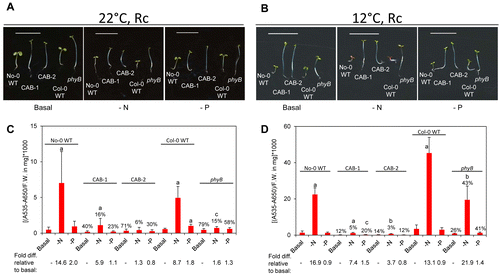
Figure 3. Development and anthocyanin content of wild-type, phytochrome-deficient and cryptochrome mutant seedlings under continuous blue light. No-0 wild-type (No-0 WT), CAB3::pBVR1 (CAB-1), CAB3::pBVR2 (CAB-2), Col-0 wild-type (Col-0 WT), phyA, cry1, and cry2 seedlings were grown at 22 °C for 4 d or 12 °C for 10 d on basal (B), nitrogen-limited (-N), or phosphate-limited (-P) Phytoblend medium with 1% sucrose under continuous B (Bc) illumination of 25 μmol m-2 s-1. (A, B) Images of seedlings. Scale bar represents 1 cm. (C, D) Anthocyanin content. Bars represent the mean (± SD) of at least 3 independent measurements. Numbers above each bar represent the percent of anthocyanins accumulated relative to WT grown on the same medium. Fold-increase values for anthocyanin levels for seedlings grown on nutrient-deficient medium relative to growth of the same line on basal medium are shown below the bar graph. Two-tailed, unpaired Mann-Whitney U-test analyses were performed to compare the means of anthocyanin contents per mg of fresh weight for a particular line on basal medium relative to respective nutrient limitations. Letters above bars: a, P < 0.001; b, P < 0.01; c, P ≤ 0.05.
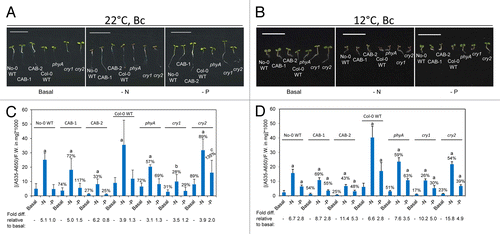
Figure 4. Light-dependent primary root lengths of wild-type, phytochrome chromophore–deficient, phytochrome apoprotein and cryptochrome apoprotein mutants. No-0 wild-type (No-0 WT), CAB3::pBVR1 (CAB-1), CAB3::pBVR2 (CAB-2), Col-0 wild-type (Col-0 WT), phyA, phyB, cry1, and cry2 seedlings were grown vertically on basal (B), nitrogen-limited (-N), or phosphate-limited (-P) Phytoblend medium containing 1% (w/v) Suc for 7 d at 22 °C under (A) far-red continuous (FRc) light of 5 µmol m−2 s−1, (B) red continuous (Rc) light of 50 µmol m−2 s−1, or (C) blue continuous (Bc) light of 25 µmol m−2 s−1. Bars represent the mean (± S.D.) of primary root lengths in mm (n = 5 to 10 for 2 independent biological experiments). For statistical significance tests comparisons were made for a particular line on basal medium relative to the respective nutrient limitations: a, P < 0.001; b, P < 0.01; c, P ≤ 0.05.
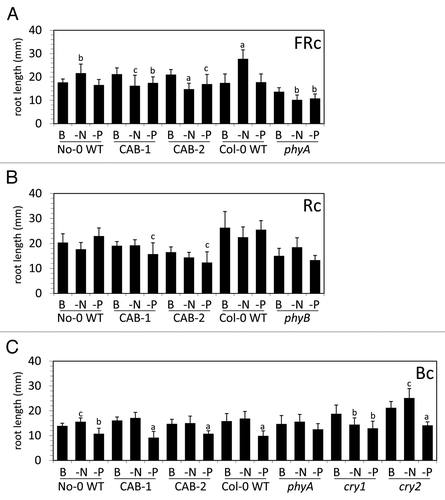
Figure 5. Root development of wild-type and phytochrome-deficient seedlings under continuous far-red light. No-0 wild-type (No-0 WT), CAB3::pBVR1 (CAB-1), CAB3::pBVR2 (CAB-2), Col-0 wild-type (Col-0 WT), and phyA seedlings were grown vertically at 22 °C for 7 d on basal, nitrogen-limited (-N), or phosphate-limited (-P) Phytoblend medium with 1% Suc under far-red continuous (FRc) illumination of 5 µmol m-2 s-1. Representative images of seedlings from 2 independent biological replicates are shown. Scale bars represent 0.5 cm.

Figure 6. Root development of wild-type and phytochrome-deficient seedlings under continuous red light. No-0 wild-type (No-0 WT), CAB3::pBVR1 (CAB-1), CAB3::pBVR2 (CAB-2), Col-0 wild-type (Col-0 WT), and phyB seedlings were grown vertically at 22 °C for 7 d on basal, nitrogen-limited (-N), or phosphate-limited (-P) Phytoblend medium with 1% sucrose under red continuous (Rc) illumination of 50 µmol m-2 s-1. Representative images of seedlings from 2 independent biological replicates are shown. Scale bars represent 0.5 cm.

Figure 7. Root development of wild-type, phytochrome-deficient and cryptochrome mutant seedlings under continuous blue light. No-0 wild-type (No-0 WT), CAB3::pBVR1 (CAB-1), CAB3::pBVR2 (CAB-2), Col-0 wild-type (Col-0 WT), phyA, cry1, and cry2 seedlings were grown vertically at 22 °C for 7 d on basal, nitrogen-limited (-N), or phosphate-limited (-P) Phytoblend medium with 1% sucrose under blue continuous (Bc) illumination of 25 µmol m-2 s-1. Representative images of seedlings from 2 independent biological replicates are shown. Scale bars represent 0.5 cm.
